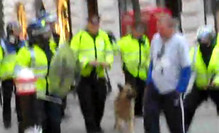
Last week an inquest into Tomlinson's death found he was unlawfully killed, after being struck with a baton and pushed to the ground by PC Simon Harwood during the G20 protests in London in 2009.
In a report published today, IPCC Commissioner Deborah Glass said there is no evidence that any press officer, or any police officer responsible for agreeing media lines, set out to mislead anyone, or that the police attempted to cover up the circumstances of his death.
But she added that these findings "does not make the circumstances surrounding the death of Mr Tomlinson any less disturbing".
"It must also be disturbing to those officially charged with investigating the death that the public turned to the media first with their evidence. To some extent this may simply reflect the reality of the modern media and internet world, but in the circumstances of this case it may also reflect the atmosphere of mistrust and suspicion of the police, among protestors.
"As events unfolded it was all too apparent that the IPCC's actual involvement in the investigation from 2 April 2009 was insufficiently known and understood by both the public and the media, and I recognise that we, too, must ensure that this does not happen again."
She said it is "entirely understandable" that the Tomlinson family should feel angered having learned of key evidence about his death from the media rather than the police or the IPCC.
"There is no doubt of the crucial role played by the media in obtaining evidence that has proved to be vital to the IPCC in its investigation into Mr Tomlinson's death," Glass added.
"It may well be the case that, but for this evidence, Mr Tomlinson's death may not have resulted in the criminal investigation that was launched by the IPCC on 8 April. However, it is also the case that those officially charged with investigating the death of Mr Tomlinson, whether City of London Police or the IPCC, obtained that crucial evidence only after the media had published it."
The investigation was carried out by Alex Louis, a communications specialist who was the IPCC's interim Director of Communications from 2006 to 2008.
As the Guardian/Observer was the first media organisation to print photographs and video images initially indicating, and then confirming, police contact with Tomlinson, some of its journalists were identified as potentially important witnesses and provided written statements to the investigation. Reporters from the BBC, Channel 4, Sky, The Times and the Evening Standard were also approached for their perspective on the media handling and police level of knowledge over the period.
In the report's final recommendations it said that in comparison to communications staff within the Metropolitan Police Service, the City of London Police press office staff "had fewer, less experienced personnel and no computerised media logging system" and were "ill-prepared for dealing with a major incident".
The IPCC said that as a result the press office should consider the need for a computerised system as well as a written protocol on the handling of incoming information by their press office, particularly that which relates to an ongoing major investigation.
Free daily newsletter
If you like our news and feature articles, you can sign up to receive our free daily (Mon-Fri) email newsletter (mobile friendly).









